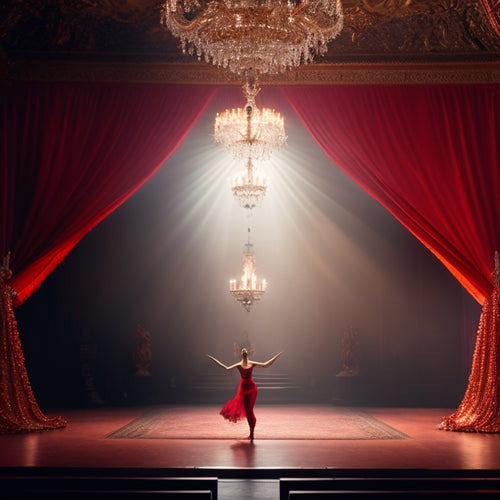
10 Essential Tips for Beginner Dance Makeup Artists
Share
As a beginner dance makeup artist, you're about to take your skills to the next level. Mastering basic makeup techniques, like blending and contouring, is essential. Choose durable, sweat-resistant products that perform well, and understand skin tones to create flawless looks. Select foundation shades that match the dancer's skin tone, and don't forget highlighting and contouring basics. Time-saving tricks and a well-organized makeup station will keep you on track. Finally, build a professional portfolio to showcase your work. With these essential tips, you'll be well on your way to becoming a pro - and there's even more to discover as you continue on this artistic journey.
Key Takeaways
• Master basic makeup techniques like blending, contouring, and highlighting through consistent practice to elevate artistry.
• Invest in durable, sweat-resistant, and easy-to-apply products that perform well, regardless of packaging.
• Understand skin tone essentials by studying a Skin Tone Chart and conducting a complexion analysis to guide product choices.
• Choose a foundation shade that matches the dancer's skin tone, considering undertones, and prep the skin before application.
• Develop a time-saving makeup routine by prepping the station beforehand, focusing on essentials during touchups, and using quick fixes.
Mastering Basic Makeup Techniques
Developing a strong foundation in basic makeup techniques is essential to creating stunning looks that wow on stage, and mastering the fundamentals of blending, contouring, and highlighting will elevate your artistry to the next level.
As a beginner dance makeup artist, it's important you dedicate time to honing your skills through consistent practice routines. Set aside time each week to practice different techniques, focusing on perfecting your brush control. You'll be amazed at how quickly your skills improve with regular practice.
Start with simple exercises like blending shifts and gradually move on to more complex techniques like contouring and highlighting. Remember, the key to mastering these techniques lies in precision and control. Practice holding your brush at different angles and pressures to achieve the desired effects.
With consistent practice and attention to detail, you'll be creating show-stopping looks in no time.
Choosing the Right Products
Having a solid foundation in basic makeup techniques under your belt, it's important to stock your kit with the right products to bring your dance makeup looks to life.
As a beginner dance makeup artist, you'll want to focus on products that are durable, sweat-resistant, and easy to apply. When it comes to product research, don't be afraid to dig deep. Read reviews, watch tutorials, and ask fellow artists for recommendations. Compare brands, considering factors like pigmentation, longevity, and ease of use.
Don't be swayed by flashy packaging or trendy marketing – focus on the product's performance. Look for products labeled 'sweat-resistant' or 'long-lasting' to make sure they can keep up with the demands of a high-energy dance performance.
Understanding Skin Tone Essentials
As a beginner dance makeup artist, you'll quickly realize that understanding skin tone essentials is essential to creating flawless, stage-ready looks that complement your dancers' natural complexions. To master this, you'll need to develop a keen eye for complexion analysis.
Start by studying a Skin Tone Chart, which categorizes skin tones into different undertones, such as cool, neutral, and warm. This will help you identify the unique characteristics of each dancer's skin.
When conducting a complexion analysis, take note of the natural undertones, overtone, and level of pigmentation. This information will guide your product choices and application techniques.
For instance, if your dancer has a cool undertone, you'll want to look for products with pink or purple undertones to counteract any sallowness.
Creating Flawless Foundation Coverage
Creating Flawless Foundation Coverage
Your foundation choice and application technique can make or break the overall look, so it's crucial you select a shade that perfectly matches your dancer's skin tone, and then apply it with precision to create an even, natural-looking base.
When choosing a foundation, consider the dancer's skin undertones. Are they cool, neutral, or warm? This will help you select a foundation formula that complements their skin tone.
Here are some essential tips to keep in mind:
-
Test foundation shades: Always test foundation shades on the dancer's jawline to find the perfect match.
-
Consider foundation formulas: Liquid, cream, or powder foundations each have their own unique characteristics - choose the one that suits your dancer's skin type.
-
Prep the skin: Make sure the dancer's skin is moisturized and primed before applying foundation.
-
Use the right tools: Invest in a good quality foundation brush or beauty blender to achieve a seamless finish.
-
Blend, blend, blend: Make sure to blend the foundation well, especially around the hairline, jawline, and edges of the face.
Highlighting and Contouring Basics
Now that you've achieved a flawless foundation, it's time to enhance your dancer's features by learning the fundamentals of highlighting and contouring, which can instantly elevate their overall look. As a beginner dance makeup artist, understanding the basics of highlighting and contouring is crucial to create a visually stunning look that accentuates your dancer's best features.
When it comes to highlighting, think of it as adding a touch of magic to your dancer's face. You'll want to apply a subtle highlighter to the high points of the face, such as the tops of the cheekbones, nose, and cupid's bow, to create a radiant glow. This will help frame the face and create the illusion of facial symmetry.
For contouring, focus on defining the facial structure by creating subtle shadows. Use a contour powder or cream that's one shade deeper than your dancer's skin tone to add depth to the hollows of the cheeks, temples, and jawline. This will help create the illusion of defined cheekbones and a slimmer nose.
Dancing With Dramatic Eyes
Your dancer's eyes are the windows to their soul, and with the right techniques, you can transform them into stunning focal points that enchant the audience. Dramatic eyes can elevate the entire performance, drawing the audience in and holding their attention. To create this enchanting look, follow these essential tips:
-
Choose the right Eye Shadow: Select shades that complement your dancer's skin tone and the performance's theme. Apply a light shade all over the lid, a medium shade on the crease, and a dark shade on the outer corner to create depth.
-
Line those lashes: Use a waterproof eyeliner to create a subtle or dramatic line, depending on the performance's style.
-
Add False Lashes: Individual lashes or a full set can add volume, drama, and glamour to the overall look.
-
Highlight the brow bone: Apply a light shade of Eye Shadow or a highlighter to make the eyes appear larger and more radiant.
-
Blend, blend, blend: Make sure to blend all Eye Shadow shades seamlessly to create a natural, flawless look.
Perfecting the Pout With Lip Art
As you've mastered the art of dramatic eyes, it's time to focus on perfecting the pout, and lip art is where you can get creative with color, texture, and design to elevate your dancer's overall look.
When it comes to lip art, it's all about accentuating your dancer's natural lip shape. Consider the lip shapes you're working with – are they full and luscious or thin and delicate? This will help you decide on the right shade and style of lip art to complement their features.
Get artistic with your lip designs, and don't be afraid to experiment with different textures and finishes. Glossy, matte, or metallic – the options are endless!
Consider the theme of the dance performance or the dancer's personality when choosing a lip art design. You can go bold and bright for a high-energy routine or opt for a more subtle, natural look for a contemporary piece.
Setting Up Your Makeup Station
Set up your makeup station like a pro by investing in a portable makeup case or bag that holds all your essentials within easy reach. This will save you time and energy, allowing you to focus on creating stunning dance makeup looks.
To create an efficient and hygienic workspace, consider the following:
-
Sanitize surfaces: Wipe down your makeup station with disinfectant wipes to prevent the spread of bacteria and germs.
-
Ergonomic layout: Arrange your products and tools in a way that promotes good posture and reduces strain on your back and hands.
-
Designate a 'dirty' area: Set aside a specific area for used products and disposable tools to prevent cross-contamination.
-
Label your products: Keep your products organized and easily identifiable with labels, making it easier to find what you need quickly.
-
Store frequently used products front and center: Keep your most-used products in an easily accessible spot to save time and reduce stress.
Time-Saving Tricks for Performances
When you're working against the clock to get multiple dancers ready for a performance, every minute counts, and mastering a few key time-saving tricks can make all the difference between a stressful scramble and a smooth, successful show.
One of the most effective time-saving tricks is to prep your makeup station beforehand. Lay out all the products and tools you need, and organize them in a way that makes sense for the looks you're creating. This will save you precious minutes during quick rehearsals when every second counts.
Another trick is to focus on the essentials during rushed touchups. Instead of trying to redo an entire look, focus on quick fixes like blotting away excess oil or adding a swipe of lip gloss. Remember, the goal is to enhance the dancers' natural features, not to create a full-glam look from scratch.
Building a Professional Portfolio
By showcasing your best work in a professional portfolio, you'll be able to demonstrate your expertise as a dance makeup artist and attract potential clients, collaborators, or even employers. A strong portfolio is essential for building your personal branding and establishing a solid online presence. It's a visual representation of your skills, creativity, and attention to detail, showcasing your ability to enhance the beauty and drama of dance performances.
Here are some essential tips to keep in mind when building your portfolio:
-
Curate your best work: Select a diverse range of images that demonstrate your expertise in different makeup styles, techniques, and themes.
-
Invest in high-quality images: Hire a professional photographer or invest in a good camera to make sure your images are crisp, clear, and well-lit.
-
Organize your portfolio: Create a logical flow and categorize your work by theme, style, or performance type.
-
Keep it concise: Limit your portfolio to 10-15 images that showcase your best work, rather than overwhelming viewers with too many options.
-
Make it easily accessible: Create a website or online platform where clients can easily view your portfolio and contact you for collaborations or bookings.
Frequently Asked Questions
How Do I Deal With Dancers Who Have Sensitive Skin or Allergies?
'When working with dancers who have sensitive skin or allergies, you'll want to prioritize skin testing and product research to guarantee their comfort and safety, so take the time to carefully vet your products and patch test before applying.'
Can I Use My Own Makeup Kit for Dance Performances?
As you prepare for the spotlight, remember your makeup kit is like a treasure chest, holding secrets to enhance your dancers' confidence. But, can you use your own kit for dance performances? Not without strict sanitation protocols and respecting their product preferences, you shouldn't.
How Do I Transport My Makeup Kit to Different Venues?
'When you're on-the-go, you'll need a reliable system; invest in a sturdy travel case and organize your kit by category, grouping similar products together, to guarantee a seamless setup at each venue.'
What if a Dancer Has a Last-Minute Costume Change?
When a dancer's costume change catches you off guard, stay calm and swiftly switch gears with quick adaptation. Reach for your trusty emergency kit, stocked with essentials, to salvage the situation and save the show.
Do I Need to Have a License to Work as a Dance Makeup Artist?
"You won't necessarily need a license, but consider obtaining certification to boost your credibility. Additionally, look into insurance options to protect yourself and your business in case of accidents or mishaps."
Related Posts
-

Why Digital Solutions Are a Game-Changer
By integrating digital solutions into your operations, you can revolutionize your workflows, discover new revenue str...
-

Must-Have Packing Cubes for Stress-Free Travel
Packing cubes are must-haves for your stress-free travel. They turn chaotic suitcases into neatly organized compartme...
-

Dance Spectacular With Limited Seating Offer
Experience the magic of dance with Santa Barbara Festival Ballet's 'Growing Up With Dance' spectacular, featuring bre...


